acetaminophen and oxycodone
Pronunciation: a SEET a MIN oh fen and OX i KOE done
Brand: Percocet 10/325, Percocet 2.5/325, Percocet 5/325, Percocet 7.5/325, Primlev, Roxicet, Xartemis XR
Acetaminophen-Oxycodone 325 mg-10 mg-MAL
oval, white, imprinted with 10/325, M523
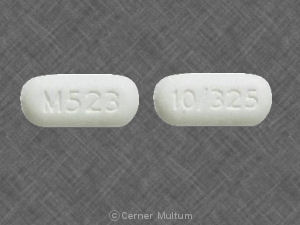
Acetaminophen-Oxycodone 325 mg-5 mg-AMN
round, white, imprinted with IP, 203
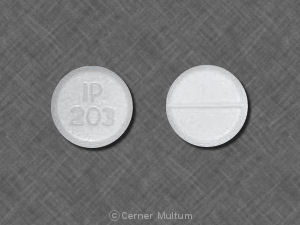
Acetaminophen-Oxycodone 325 mg-5 mg-MAL
round, white, imprinted with 512
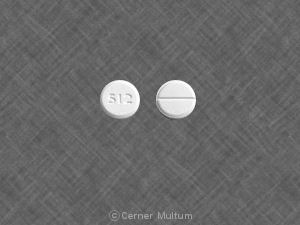
Acetaminophen-Oxycodone 325 mg-7.5 mg-MAL
oval, white, imprinted with 7.5/325, M522
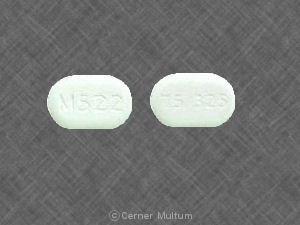
APAP-Oxycodone 325 mg-5 mg-BAR
round, white, imprinted with 555 278
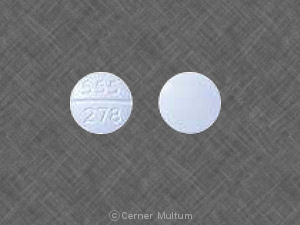
Endocet 325 mg-10 mg
capsule, yellow, imprinted with 10/325, E712
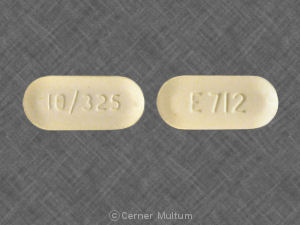
Endocet 325-5 mg
round, white, imprinted with Endo 602
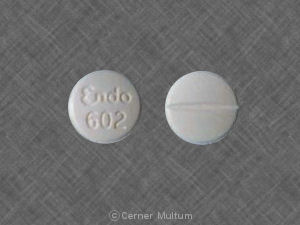
Endocet 7.5-325 mg
oval, orange, imprinted with 7.5/325, E700
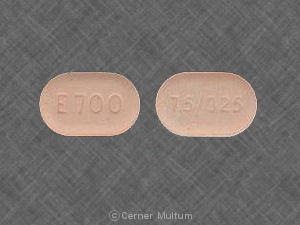
Oxycodone-APAP 10-325 mg-WAT
round, white, imprinted with WATSON 932
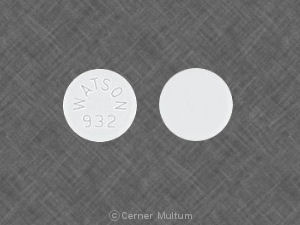
Oxycodone-APAP 5-325 mg-WAT
round, white, imprinted with WATSON 749
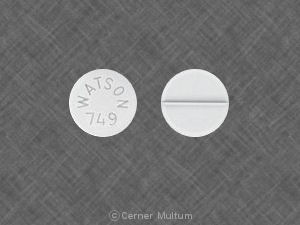
Oxycodone-APAP 7.5-325 mg-WAT
round, white, imprinted with WATSON 933
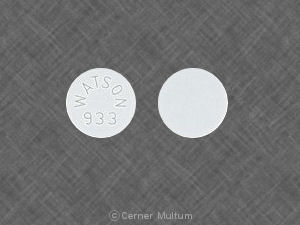
Percocet 10-325 mg
capsule, yellow, imprinted with 10/325, PERCOCET
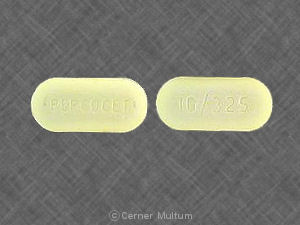
Percocet 2.5-325 mg
oval, pink, imprinted with 2.5, PERCOCET
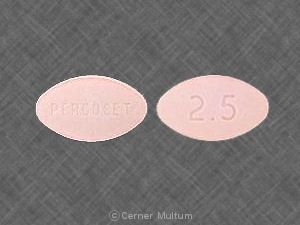
Percocet 325-5 mg
round, blue, imprinted with PERCOCET 5
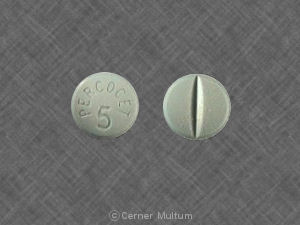
Percocet 7.5-325 mg
oval, orange, imprinted with PERCOCET, 7.5/325
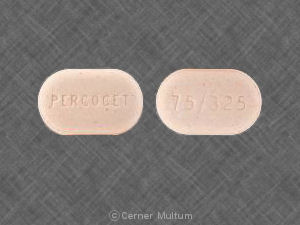
Roxicet
round, white, imprinted with 54 543
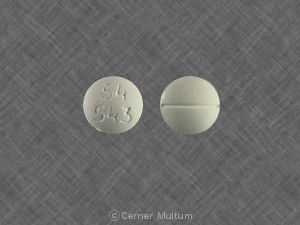
What is the most important information I should know about acetaminophen and oxycodone?
This medicine can slow or stop your breathing, and may be habit-forming. Use only your prescribed dose, and swallow the pill whole to avoid a potentially fatal dose. Never share acetaminophen and oxycodone with another person.
MISUSE OF THIS MEDICINE CAN CAUSE ADDICTION, OVERDOSE, OR DEATH, especially in a child or other person using the medicine without a prescription.
Taking this medicine during pregnancy may cause life-threatening withdrawal symptoms in the newborn.
An overdose of acetaminophen can damage your liver or cause death. Call your doctor at once if you have nausea, pain in your upper stomach, itching, loss of appetite, dark urine, clay-colored stools, or jaundice (yellowing of your skin or eyes).
Stop taking this medicine and call your doctor right away if you have skin redness or a rash that spreads and causes blistering and peeling.
Fatal side effects can occur if you use this medicine with alcohol, or with other drugs that cause drowsiness or slow your breathing.
What is acetaminophen and oxycodone?
Oxycodone is an opioid pain medication, sometimes called a narcotic. Acetaminophen is a less potent pain reliever that increases the effects of oxycodone.
Acetaminophen and oxycodone is a combination medicine used to relieve moderate to severe pain.
Acetaminophen and oxycodone may also be used for purposes not listed in this medication guide.
What should I discuss with my healthcare provider before taking acetaminophen and oxycodone?
You should not use this medicine if you are allergic to acetaminophen (Tylenol) or oxycodone, or if you hvae:
- severe asthma or breathing problems; or
- a blockage in your stomach or intestines, including paralytic ileus.
To make sure this medicine is safe for you, tell your doctor if you have ever had:
- any type of breathing problem or lung disease;
- liver disease, cirrhosis, or if you drink alcohol daily;
- drug or alcohol addiction, or mental illness;
- kidney disease, urination problems;
- problems with your gallbladder, pancreas, thyroid, or adrenal gland; or
- a head injury, brain tumor, or seizures.
Some medicines can interact with oxycodone and cause a serious condition called serotonin syndrome. Be sure your doctor knows if you also take stimulant medicine, herbal products, or medicine for depression, mental illness, Parkinson's disease, migraine headaches, serious infections, or prevention of nausea and vomiting. Ask your doctor before making any changes in how or when you take your medications.
If you use oxycodone while you are pregnant, your baby could become dependent on the drug. This can cause life-threatening withdrawal symptoms in the baby after it is born. Babies born dependent on habit-forming medicine may need medical treatment for several weeks. Tell your doctor if you are pregnant or plan to become pregnant.
Do not breast-feed. Acetaminophen and oxycodone can pass into breast milk and may cause drowsiness or breathing problems in a nursing baby.
How should I take acetaminophen and oxycodone?
Follow all directions on your prescription label. Oxycodone can slow or stop your breathing, especially when you start using this medicine or whenever your dose is changed. Never use this medicine in larger amounts, or for longer than prescribed. An overdose can damage your liver or cause death. Tell your doctor if the medicine seems to stop working as well in relieving your pain.
Oxycodone may be habit-forming, even at regular doses. Never share this medicine with another person, especially someone with a history of drug abuse or addiction. MISUSE OF NARCOTIC MEDICINE CAN CAUSE ADDICTION, OVERDOSE, OR DEATH, especially in a child or other person using the medicine without a prescription. Selling or giving away acetaminophen and oxycodone is against the law.
Measure liquid medicine with a special dose-measuring spoon or medicine cup. If you do not have a dose-measuring device, ask your pharmacist for one.
Do not crush, break, or open an extended-release pill. Swallow it whole to avoid exposure to a potentially fatal dose. Never crush or break a pill to inhale the powder or mix it into a liquid to inject the drug into your vein.
If you need surgery, tell the surgeon ahead of time that you are using this medicine. You may need to stop using the medicine for a short time.
Do not stop using this medicine suddenly after long-term use, or you could have unpleasant withdrawal symptoms. Ask your doctor how to safely stop using the medicine.
Store at room temperature away from moisture and heat. Keep track of your medicine. Oxycodone is a drug of abuse and you should be aware if anyone is using your medicine improperly or without a prescription.
Do not keep leftover opioid medication. Just one dose can cause death in someone using this medicine accidentally or improperly. Ask your pharmacist where to locate a drug take-back disposal program. If there is no take-back program, flush the unused medicine down the toilet.
What happens if I miss a dose?
Since this medicine is used for pain, you are not likely to miss a dose. Skip any missed dose if it is almost time for your next scheduled dose. Do not use extra medicine to make up the missed dose.
What happens if I overdose?
Seek emergency medical attention or call the Poison Help line at 1-800-222-1222. An overdose can be fatal, especially in a child or other person using this medicine without a prescription. Overdose can cause severe muscle weakness, pinpoint pupils, very slow breathing, extreme drowsiness, or coma.
The first signs of an acetaminophen overdose include loss of appetite, nausea, vomiting, stomach pain, sweating, and confusion or weakness.
What should I avoid while taking acetaminophen and oxycodone?
Do not drink alcohol. Dangerous side effects or death could occur.
This medicine may impair your thinking or reactions. Avoid driving or operating machinery until you know how this medicine will affect you. Dizziness or severe drowsiness can cause falls or other accidents.
Ask a doctor or pharmacist before using any other cold, allergy, pain, or sleep medication. Acetaminophen (sometimes abbreviated as APAP) is contained in many combination medicines. Taking certain products together can cause you to get too much acetaminophen which can lead to a fatal overdose.
What are the possible side effects of acetaminophen and oxycodone?
Get emergency medical help if you have signs of an allergic reaction: hives; difficulty breathing; swelling of your face, lips, tongue, or throat.
In rare cases, acetaminophen may cause a severe skin reaction that can be fatal. This could occur even if you have taken acetaminophen in the past and had no reaction. Stop taking this medicine and call your doctor right away if you have skin redness or a rash that spreads and causes blistering and peeling.
Like other narcotic medicines, oxycodone can slow your breathing. Death may occur if breathing becomes too weak.
Call your doctor at once if you have:
- noisy breathing, sighing, shallow breathing;
- slow heartbeat or weak pulse;
- a light-headed feeling, like you might pass out;
- confusion, unusual thoughts or behavior;
- weakness, tiredness, fever, unusual bruising or bleeding;
- problems with urination; or
- liver problems --nausea, upper stomach pain, loss of appetite, dark urine, clay-colored stools, jaundice (yellowing of the skin or eyes).
Seek medical attention right away if you have symptoms of serotonin syndrome, such as: agitation, hallucinations, fever, sweating, shivering, fast heart rate, muscle stiffness, twitching, loss of coordination, nausea, vomiting, or diarrhea.
Serious side effects may be more likely in older adults and those who are overweight, malnourished, or debilitated.
Long-term use of opioid medication may affect fertility (ability to have children) in men or women. It is not known whether opioid effects on fertility are permanent.
Common side effects include:
- dizziness, drowsiness;
- feelings of extreme happiness or sadness;
- nausea, vomiting;
- constipation; or
- itching.
This is not a complete list of side effects and others may occur. Call your doctor for medical advice about side effects. You may report side effects to FDA at 1-800-FDA-1088.
What other drugs will affect acetaminophen and oxycodone?
Narcotic (opioid) medication can interact with many other drugs and cause dangerous side effects or death. Be sure your doctor knows if you also use:
- other narcotic medications --opioid pain medicine or prescription cough medicine;
- a sedative like Valium --diazepam, alprazolam, lorazepam, Ativan, Klonopin, Restoril, Tranxene, Versed, Xanax, and others); or
- drugs that make you sleepy or slow your breathing --a sleeping pill, muscle relaxer, tranquilizer, antidepressant, or antipsychotic medicine.
This list is not complete. Other drugs may interact with acetaminophen and oxycodone, including prescription and over-the-counter medicines, vitamins, and herbal products. Not all possible interactions are listed in this medication guide.
Where can I get more information?
Your pharmacist can provide more information about acetaminophen and oxycodone.
Remember, keep this and all other medicines out of the reach of children, never share your medicines with others, and use this medication only for the indication prescribed.
Every effort has been made to ensure that the information provided by Cerner Multum, Inc. ('Multum') is accurate, up-to-date, and complete, but no guarantee is made to that effect. Drug information contained herein may be time sensitive. Multum information has been compiled for use by healthcare practitioners and consumers in the United States and therefore Multum does not warrant that uses outside of the United States are appropriate, unless specifically indicated otherwise. Multum's drug information does not endorse drugs, diagnose patients or recommend therapy. Multum's drug information is an informational resource designed to assist licensed healthcare practitioners in caring for their patients and/or to serve consumers viewing this service as a supplement to, and not a substitute for, the expertise, skill, knowledge and judgment of healthcare practitioners. The absence of a warning for a given drug or drug combination in no way should be construed to indicate that the drug or drug combination is safe, effective or appropriate for any given patient. Multum does not assume any responsibility for any aspect of healthcare administered with the aid of information Multum provides. The information contained herein is not intended to cover all possible uses, directions, precautions, warnings, drug interactions, allergic reactions, or adverse effects. If you have questions about the drugs you are taking, check with your doctor, nurse or pharmacist.
Copyright 1996-2018 Cerner Multum, Inc. Version: 16.01. Revision date: 12/12/2017.